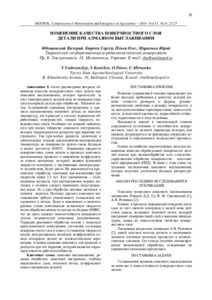Please use this identifier to cite or link to this item:
http://elar.tsatu.edu.ua/handle/123456789/3143Full metadata record
| DC Field | Value | Language |
|---|---|---|
| dc.contributor.author | Юдовинский, В. | - |
| dc.contributor.author | Кюрчев, Сергей Владимирович | - |
| dc.contributor.author | Пенев, О. | - |
| dc.contributor.author | Мирненко, Ю. П. | - |
| dc.contributor.author | Yudovynskyy, V. | - |
| dc.contributor.author | Kurtchеv, S. | - |
| dc.contributor.author | Penov, O. | - |
| dc.contributor.author | Mirnenko, U. | - |
| dc.date.accessioned | 2018-05-18T08:28:19Z | - |
| dc.date.available | 2018-05-18T08:28:19Z | - |
| dc.date.issued | 2015 | - |
| dc.identifier.uri | http://elar.tsatu.edu.ua/handle/123456789/3143 | - |
| dc.description.abstract | RU: В статье рассмотрены вопросы изменения качества поверхностного слоя детали при алмазном выглаживании, которое происходит за счет температурного воздействия на поверхностные слои материала детали при обработке. Тепловой поток, создаваемый алмазным инструментом в процессе выглаживания, нагревает деталь до высоких температур, что приводит к отпуску термически обработанных поверхностей, снижая твердость поверхностных слоев. Особенно это влияние наблюдается при малых габаритах алмазного инструмента, которое характеризуется радиусом при вершине инструмента. Так при малых радиусах индентора и значительных усилиях выглаживания максимальная температура на поверхности детали очень большая и может достигать 1000°С. Изменение твердости поверхностных слоев детали в процессе алмазного выглаживания, приводит к изменению коэффициента износа материала, который, являясь функцией твердости материала, с увеличением температурного воздействия, будет расти. Не рекомендуется производить обработку алмазным выглаживанием при скоростях выше 2,5 м/с. Как смазывающе – охлаждающая жидкость при выглаживании черных металлов и сплавов следует применять индустриальное масло 20, а при обработке цветных металлов и сплавов - керосин. Поэтому, процесс алмазного выглаживания требует интенсивного охлаждения инструмента и детали. Даже в закаленных и цементируемых сталях максимально возможную твердость после обработки можно получить не больше 40HRC, что на треть снижает износостойкость поверхности детали, подвергнутой алмазному выглаживанию. Управляя режимами обработки можно с помощью представленной номограммы уточнения состояния поверхностного слоя к износу и снижения твердости можно контролировать величину коэффициента износа материала детали по технологическим параметрам: усилием прижима алмазного инструмента и радиусом при его вершине, который является характеристикой ее работоспособности. EN: In the article the questions of change of quality of superficial layer of detail are considered at the diamond pressing which takes place due to the temperature affecting superficial layers of material of detail at treatment. A thermal stream, created a diamond instrument in the process of pressing, heats a detail to the high temperatures, that results in vacation of the thermally treated surfaces, reducing hardness of superficial layers. This influence is special observed at the small sizes of diamond instrument, which is characterized a radius at the top of instrument. So at the small radiuses of indentora and considerable efforts of pressing a maximal temperature on-the-spot detail is very large and can arrive at 1000°S. Change hardness of superficial layers of detail in the process of the diamond pressing, causes the change of coefficient of wear of material which, being the function of hardness of material, with the increase of temperature influence, will grow. It is not recommended to produce treatment the diamond pressing at speeds higher 2,5 m/s. As an oiling – cooling liquid at pressing of black metals and alloys it is necessary to apply industrial butter 20, and at treatment of the coloured metals and alloys is kerosene. Therefore, the process of the diamond pressing requires the intensive cooling of instrument and detail. Even in hard-tempered and cemented stalyakh maximally possible hardness after treatment it is possible to get no more 40hrc, that on the third reduces wearproofness of surface of detail, exposed to the diamond pressing. Managing the modes of treatment it is possible by the presented nomogram of clarification of the state of superficial layer to the wear and decline of hardness it is possible to control the size of coefficient of wear of material of detail on technological parameters: by effort of clamp of diamond instrument and radius at his top, which is description of its capacity. | uk |
| dc.language.iso | ru | uk |
| dc.relation.ispartofseries | MOTROL. Commission of Motorization and Energetics in Agriculture;Vol. 17, No. 9 | - |
| dc.subject | алмазное выглаживание | uk |
| dc.subject | режимы обработки | uk |
| dc.subject | алмазный инструмент | uk |
| dc.subject | глубина наклепанного слоя | uk |
| dc.subject | тепловой поток | uk |
| dc.subject | коэффициент износа материалов деталей | uk |
| dc.subject | diamond pressing | uk |
| dc.subject | modes of treatment | uk |
| dc.subject | diamond instrument | uk |
| dc.subject | depth of naklepannogo layer | uk |
| dc.subject | thermal stream | uk |
| dc.subject | coefficient of wear of materials of details | uk |
| dc.title | Изменение качества поверхностного слоя детали при алмазном выглаживании | uk |
| dc.title.alternative | Change of quality of superficial layer of detail at diamond pressing | uk |
| dc.type | Working Paper | uk |
| Appears in Collections: | Кафедра Інженерної механіки та комп'ютерного проектування | |
Files in This Item:
| File | Description | Size | Format | |
|---|---|---|---|---|
| 38-23-28.pdf | 564.75 kB | Adobe PDF |  View/Open |
Show simple item record
CORE Recommender
???jsp.display-item.check???
Items in DSpace are protected by copyright, with all rights reserved, unless otherwise indicated.
